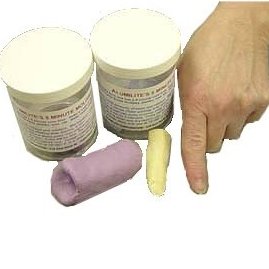Of all the mold making material selections to choose from, I most often utilize 2-part RTV silicone rubber for my molding and casting projects.
Though a bit more expensive than other mold making material choices, silicone rubber is a very versatile, easy-to-use material, as it can be used to reproduce almost anything without harm to surfaces–often without requiring a release agent. Silicone molds replicate without the loss of the intricacies of the original, as silicone rubbers will capture the minutest of detail, even down to the fingerprints.
Within the family of silicone materials that are available, one can select a very soft rubber to aid in de-molding of undercuts, or a more firmer silicone which will provide a longer life and many more castings without losing detail. Apart from being easy and safe to use, many silicone rubber molds have a fairly long library life. You can continue to use the same mold or molds for reproductions again and again, which often offsets the higher cost of silicone rubber. In particular, platinum catalyzed silicones (also know as addition-cure) can be archived for up to twenty years. Though tin-catalyzed silicone experience shorter lives of around five years.
What's more, the same silicone rubber compound can not only be used for mold making, it can also be used as casting material, too. For example, SkinRite 10, a translucent silicone is used to cast prosthetics, dolls and realistic looking body parts is a silicone rubber often used for casting. However, the downside is that silicone does not stick to anything apart from itself. Thus, a good mold release must be carefully used when casting silicone into a silicone mold. So I prefer not to make silicone molds and castings of the same object, instead I used polyurethane rubber for the mold if I will use silicone for the casting agent.
Of all the varieties of silicone mold rubbers available on the market, my particular favorite is a two-part putty-like silicone material that sets in only five-minutes. The fast curing product stands up to its name as it can make a traditional silicone mold very quickly and easily, and without using a mold box. I use it often for making quick impressions and also for food molds as it complies with FDA standards.
The material comes in two parts, each part about the thickness of standard putty. To use, cut equal parts of Part A and Part B and then combine them, mixing them in your palm. Each part is a different color so once the colors are fully blended without any marbling the silicone has been properly combined. Simply place the thick putty around the original piece. It's set in five minutes. It is thick thst enough when cured, it usually does not need a mother mold or a mold box, another benefit of this product.
No matter what your mold making material preferences are, I recommend that you experiment with this fast curing silicone product. Keep some on hand in your studio as it can be a real time saver with a set time of only five minutes compared to those traditional silicones that normally take several hours to cure.
Happy mold making and casting!!





